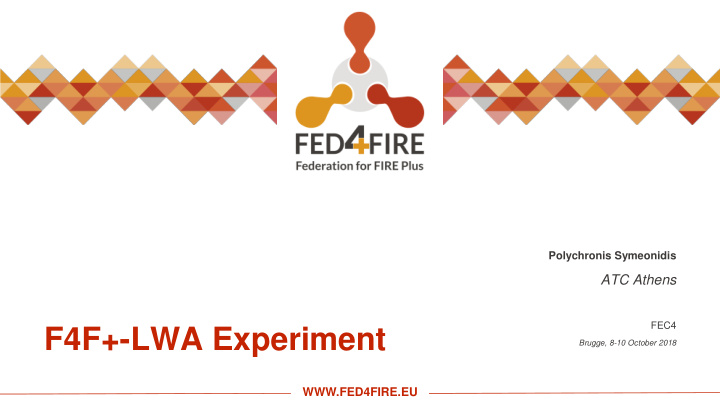



Polychronis Symeonidis ATC Athens FEC4 F4F+-LWA Experiment Brugge, 8-10 October 2018 WWW.FED4FIRE.EU
F4F+ Cloud based LTE WiFi Aggregation OC2 – STAGE 2 EXPERIMENT
Experiment Description • Traditional base stations embed functionality in software/hardware for up to L2 of the OSI stack. • Centralized baseband processing for each base station, taking place to the cloud, contrary to legacy setups. • NGFI: Six different splits of the base station functionality have been proposed. • Depending on the point of where the split takes place, different requirements are posed for the fronthaul interface 3 WWW.FED4FIRE.EU
Experiment Goals To develop the functionality for the aggregation of 1) HetNets in the Cloud (stage 1) Experimentally evaluate the 2) functionality (stage 1) Develop policies for the dynamic network 3) selection from the base station point of view (stage 2) Organize the HetNets based on the 4) spectral efficiency of the network, through a Cloud based controller (stage 2) 4 WWW.FED4FIRE.EU
Stage 2 contributions Stage 2 contributions: Develop new signaling between Central Units (CUs – placed in the cloud) • and Distributed Units (DUs- RF frontend) for: • Advertising current network status (wireless network parameters) • Instructing DUs to change their configuration or network settings (e.g. number of antennas, MIMO, secondary channel configuration for 802.11n, etc.) • Instructing DUs to shutdown if clients are currently served by another DU for energy efficiency purposes • Periodically report their wireless network status • Using the OpenAirInterface platform over the NITOS testbed 5 WWW.FED4FIRE.EU
New Signaling – protocol for advertising settings 6 WWW.FED4FIRE.EU
Experiment Setup • NITOS testbed was used • Open Source LTE functionality over Software Defined Radio (SDR) devices • Off-the-shelf WiFi devices • Off-the-shelf User Equipment for the tests 7 WWW.FED4FIRE.EU
Experiment Results (Stage 1) • Two different types of fronthaul interface was used (TCP/UDP) • Small communication overhead with our protocol • When aggregating the links, the wireless channel capacity increases by over 50% 8 WWW.FED4FIRE.EU
Experimentation Results (Stage 2) Coordination Results LTE-U and WiFi use channel 1 Coordination algorithm instructs WiFi DU to change its channel No transmissions configuration (through Channel Switch Announcement) 9 WWW.FED4FIRE.EU
Experimentation Results (Stage 2) Energy Efficiency Results • Which technology/distributed unit to select for serving a data hungry client of the network (switch on/off LWA) • Getting real measurements from the testbed was not helpful: • LTE runs over SDRs and hence consumes significantly more energy than the off-the-shelf WiFi cards • Used stub values for doing proof-of-concept experiment • Switching off WiFi DUs in case the clients can be served from an LTE cell 10 WWW.FED4FIRE.EU
Impact of our experiment (1/3) • Strengthening our company's competitiveness and positioning in the delivery and evaluation of 5G solutions • Development of network specific monitoring tools • Set of KPIs for the evaluation of similar solutions • Tools for characterizing the Midhaul/Fronthaul interface of 5G architectures. 11 WWW.FED4FIRE.EU
Impact of our experiment (2/3) • Deployment of ultra-dense C-RAN based heterogeneous networks • Network selection and switching, based on demand and network utilization in a single geographical area. • Charging policies for multiple tenants of the infrastructure? • Power consumption? 12 WWW.FED4FIRE.EU
Impact of our experiment (3/3) • Fully working prototype for aggregating different technologies • Tailor our media related products and evaluate them in large scale setups • Ideal case: 15 base stations in LWA setup and UEs maintaining connections to more than 3 at each time • Evaluate how UHD adaptive video streaming is affected 13 WWW.FED4FIRE.EU
Feedback to F4F+ • Used Resources • NITOS testbed: • SDR node for running the software based LTE eNB (with splitted functionality) • NITOS node for running the WiFi remote unit (using off-the-shelf WiFi cards) • NITOS node for running the UE (WiFi and LTE connectivity) • NITOS nodes for running the Core Network (MME/HSS/S-GW, P-GW) • OMF framework to load images on the nodes • Traffic generators on both ends of the network (Core and UE) • Booking of resources through the NITOS scheduler 14 WWW.FED4FIRE.EU
Feedback to F4F+ • Testbed is easy to start experimenting with • Documentation is available for the different functionality provided by the nodes • Support by the NITOS team was provided whenever we needed • Custom scripts were provided for running the different network components with an automated manner (e.g. setting up the WiFi AP) • Overall smooth experience 15 WWW.FED4FIRE.EU
WWW.FED4FIRE.EU This project has received funding from the European Union’s Horizon 2020 research and innovation programme, which is co-funded by the European Commission and the Swiss State Secretariat for Education, Research and Innovation, under grant agreement No 732638.
Recommend
More recommend